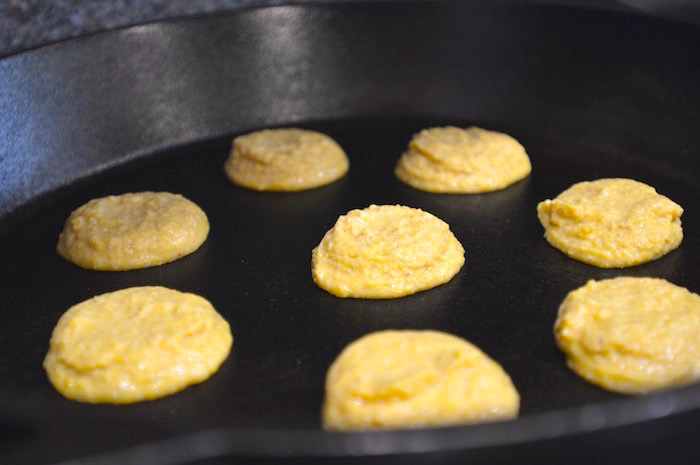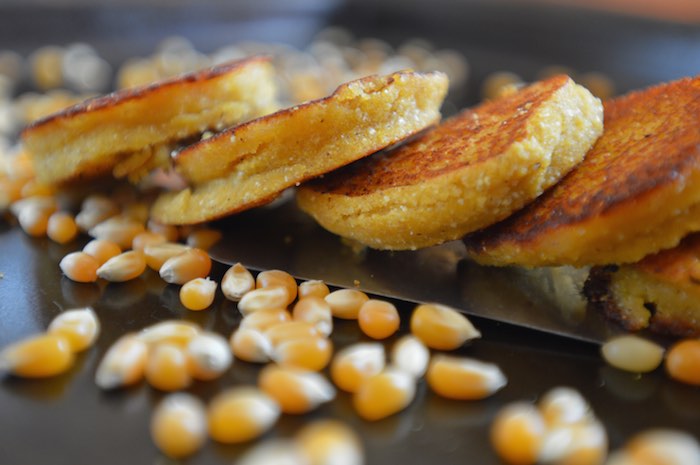
Hoecakes??
My Farmer remembers eating these golden corn cakes when he was but a boy growing up here on the Tennessee farm. He called them “Hoecakes”. When he ventured to the far country of Michigan for college, however, he received great deal of ribbing from his buddies when he started talking about eating hoecakes back home. Hoecakes?? They thought he must be referring to a pastry from a less than genteel establishment. He assured them that these were common fare for Tennessee.
I first tasted this Southern delicacy at my mother-in-law’s house one Sunday at lunch. (Sunday lunch at her house after church is a lovely tradition!) Mmmm! As my eldest Farmer Boy says, “I could eat 12 of these!” Although these may bear the the title of hot water cornbread, they will forever be known as “Hoecakes” on our farm!
How about you? What do you call them? Hot water cornbread? Hoecakes? Ever heard of these before?

Cornmeal
I grind organic popcorn in my grain mill to produce the medium grind cornmeal for this recipe. Other types of popcorn or yellow dent corn may also be ground to produce cornmeal. If you live locally, you may purchase cornmeal and other milled flours directly from me (see “Local Market” section below for further details.)
If you purchase already ground cornmeal, ensure that it is cornmeal only and not cornmeal mix (which would contain leavening and other ingredients that would affect the outcome of the recipe). In local stores such as Kroger or Publix you may find Bob’s Red Mill cornmeal that would work well for this recipe (it is often found in the health foods section of stores.) See page bottom for online product links.
Batter
I like to be exact with recipe amounts, but I just can’t tell you the specific amount of water to add to this recipe. (The type of cornmeal and flour that you use will affect the thickness of the batter.) Here’s a picture, though. It’s drippy enough to drip a few drops off of the spoon, but not so drippy that it all pours off. (Look at that phonics finesse! I included the “D-R” blend four times into a sentence!) I’ll describe it as a happy medium between pancake batter and cookie dough.
Sweet cornbread… or not? I have found that adding a touch of honey to these gives it just the right amount of sweetness. If, however, you prefer to omit the honey, you may need to add a little extra boiling water in its place.
The good news is that you can refrigerate this batter if you only want to make a few cakes at a time. (Say, for instance, you get interrupted by a screaming toddler who is having a meltdown before dinner…) If the batter seems a little thick once you remove it from the refrigerator, just add another tablespoon or two of boiling water until you achieve the desired consistency. It should spread a little once it hits the sizzling skillet, but it should not be runny.
Nutrition Bite: Corn boasts a brilliant array of carotenoids. The bright yellow color of this batter is compliments of the antioxidant carotenoids lutein and zeaxanthin, which are found in high concentration in yellow cornmeal. These carotenoids play an important role in maintaining eye health and may help decrease the risk of cataract formation and macular degeneration. As with all nutrients, intake of these antioxidants from food itself is highly preferable to intake from an isolated supplement!
Cooking in Cast Iron and Why Spatula Choice Matters
These cornbread cakes cook perfectly in cast iron with only a minimal amount of fat. If you don’t have a cast iron skillet, use a heavy bottomed stainless steel skillet (like this one from Cusinart). I like to use palm shortening or coconut oil (these are natural, non-hydrogenated fats) to fry these cakes. A little bacon grease thrown in for good measure ramps up the flavor. For a 15-inch cast iron skillet I used about 1-1/2 tablespoons oil. You can add a little more oil for more of a deep-fried effect if you would like, but I don’t like mine too greasy.
Make sure to use a high quality metal spatula on your cast iron skillet. That is one of the first steps to ensuring you maintain a nice, smooth cooking surface. I use one by Dexter-Russell — its high quality stainless steel construction has held up well to constant use in my kitchen (see pictured link at the bottom of this post). The somewhat honed edge and inflexible design of this spatula work well on cast iron to help scrape up all of those delicious browned bits without pitting the surface.
I do put my spatula in the dishwasher, but I apply a light layer of walnut oil to the handle ever so often to ensure that the wood does not crack (just apply a little oil to a paper towel and rub it over the surface of the wood). Walnut oil polymerizes at room temperatures (meaning that it forms a thin, paint-like film on the surface of the wood) and is a food-surface safe oil. Walnut oil is an effective natural alternative to the mineral based oil sold for use with wooden cookware (mineral oil is derived from petroleum). Specialty food stores, or even the oil section of some grocery stores, sometimes carry walnut oil. See page bottom for an online link to purchase walnut oil.
Here’s the Scoop!
By the way, stainless steel food service scoops are a perfect way to scoop out coconut oil or palm shortening — especially during the winter when these oil are so solid! You won’t bend your metal spoons trying to dig it out of the container. The scoops that I use are made by Volrath and are actually called “dishers“, but I prefer to call them “scoops“. You can purchase them on Amazon (see pictured link at the bottom of this post) or food service supply stores. I actually bought some of mine at Gordon’s Food Service (GFS). These scoops make portioning so easy and they are very durable (I’ve had mine for years!) If you like to make sure your portions are exact and even I would highly recommend these! The scoop sizes can be a little confusing. The larger the scoop number, the smaller the scoop. I was first introduced to the ease of using scoops during “Quantity Foods Preparation Class” in college (that’s the exciting class where you have the opportunity to make 50 gallons of soup and immerse your arms up to your elbows in 20 pounds of meatloaf mixture!)
The cornbread pictured here is scooped with my purple scoop (#40 scoop | 3/4 oz ). I usually use my yellow scoop (#20 scoop | 1-5/8 oz ) to portion out the batter for my cornbread because my Farmer likes the cakes a little larger.

Serving Suggestions
My Farmer remembers eating these hoecakes primarily alongside what he refers to as “Hash”. Anyone else heard of this dish? His simple recipe includes leftover 2-3 day-old pot roast, cubed potatoes, peas, onions, and Worcestershire sauce. Add all of these ingredients to the pot along with a bit of water, heat until simmering, and you have a meal. It sounds like “Hash” was one of those recipes invented to clean out the refrigerator, but I am convinced that my Farmer will eat anything containing Worcestershire sauce!
Serve these hoecakes as a side with a barbecue meal or as an accompaniment to vegetable soup. OR, try your hand at “Hash”. Scoop taco meat onto these and garnish with cheese and sour cream and you have a “Hillbilly Taco”! Serve alongside some blackeyed peas or pinto beans and you have a complete protein (and a wholesomely delicious and easy meal!)
For a sweeter treat, slather with apple butter… or drizzle honey, maple syrup, sorghum, or molasses on top.

- 3 cups cornmeal (14 oz) (medium to fine grind) – I ground 2 cups popcorn in my grain mill
- 3 T soft white wheat flour (whole wheat pastry flour)
- 2 t sea salt
- 3/4 cup whole milk
- 1 cup boiling water
- 1/4 cup honey
- Preheat a cast iron skillet to medium heat. Add 1-2 tablespoons palm shortening or coconut oil to pan.
- Whisk together dry ingredients in a medium-sized mixing bowl.
- Pour in milk, honey, and boiling water. Mix well.
- Scoop batter onto skillet and cook on medium heat about 2-3 minutes per side or until golden brown.
Local Market by A Spoon Full of Yum
A Spoon Full of Yum sells freshly milled cornmeal, as well as and other high quality baking ingredients, directly to customers in the Nashville, Tennessee area. For more information, please email me (Bethany@aspoonfullofyum.com) or use the contact form provided on the “Local Market” section of the side bar.

I don’t know anything about “hot water cornbread,” but hoecakes…yum-yum 🙂
Well this was great for me to read! I love healthy and homemade! I was just wanting some cornbread for dinner the other night. I picked up the jiffy box and read the ingredients and said “no, I’m not buying this anymore, it has lists of things I can’t pronounce much less know what they are!” Can’t wait to try this recipe for a cornbread or hoecake night!
…and you can pronounce all the ingredients in this recipe! Hope it’s a winner for your family! (And you can always make your own mix by mixing together and extra recipe of just the dry ingredients and putting them in a freezer safe container, labeled with the contents, and you will only have to add the liquid ingredients the next time you want real cornbread in a “jiffy”!)